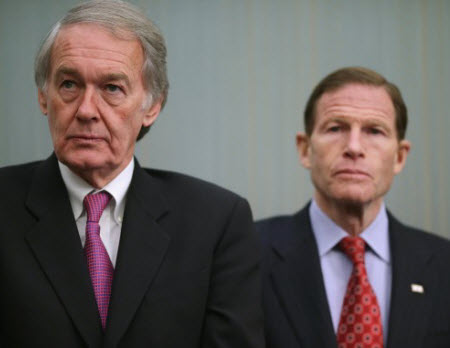Updated: Sens. Slam Pay TV Set-Top Market

Sens. Ed Markey (D-Mass.) and Richard Blumenthal (D-Conn.) say information they collected from the top 10 pay TV providers indicates a continuing lack of choice and competition in the Pay TV video set-top box market.
That comes as the FCC works on a downloadable set-top security successor to the CableCARD after its integration ban was legislated away in the STELAR satellite reauthorization legislation.
Markey and Blumenthal decried that lack of competition (the ban was scrapped in part because it had failed to prompt a robust competitive box market) and said their info showed that households were spending north of $231 per year on set-top rental fees.
The senators asked for the info last November.
“Consumers should have the same range of choices for their video set-top boxes as they have for their mobile phones,” said Markey, who had opposed shelving the integration ban, in a joint statement outlining some of the findings. "When Congress last year regrettably removed the requirement that cable company services be compatible with set-top boxes purchased in the marketplace rather than rented directly from the provider, we doomed consumers to being captive to cable company rental fees forever."
“Consumers deserve protection against hidden, hideously vexing fees for set-top boxes,” added Blumenthal.
Answering the survey were Comcast, DirecTV, Dish Network, Time Warner Cable, Charter Communications, AT&T U-Verse, Verizon FiOS Video, Cox Communications, Cablevision Systems and Bright House Networks.
Multichannel Newsletter
The smarter way to stay on top of the multichannel video marketplace. Sign up below.
The senators pointed out that that was a 10 out of 10 response rate, but added that Dish, DirecTV and Time Warner Cable declined to answer many questions on proprietary grounds while others answered those same questions.
Among the other findings:
"1) "American MVPD subscribers spend, on average, $89.16 a year renting a single set-top box. The average set-top box rental fee for each company was used to calculate an overall set-top box rental cost average across companies: $7.43 a month, or $89.16 per year.
2) "The average household spends $231.82 a year on set-top box rental fees. The responses to Senators’ letters indicate that the average number of set top boxes leased to a household is approximately 2.6. That number, multiplied by the average cost of a set-top box, totals $231.82.
3) "The set-top box rental market may be worth more than $19.5 billion per year. According to publicly available information, there are approximately 221 million installed set-top boxes that are leased from MVPDs (including cable, satellite and telecom operators). Using this data, the average yearly fee for a single set-top box was multiplied by the total number of set-top boxes leased from MVPDs to determine that the industry generates $19.5 billion in revenue."
The National Cable & Telecommunications Association countered that the senators were misreprenting the issue and the STELAR Act.
“In today’s competitive video marketplace, American consumers have a growing number of choices of video providers and ways to access video content on multiple devices in and out of the home," said the NCTA in response. "Retail devices including TiVo, Roku and Apple TV have been purchased by tens of millions of consumers. Pay TV and content providers have embraced the mobile marketplace and offer robust apps that have been downloaded 52 million times on Apple and Android devices.
"In 2014, an overwhelmingly bipartisan Congress wisely enacted legislation that sunset an unnecessary and expensive mandate that saddles consumers of cable leased set-top boxes with high costs and higher energy bills. And as even TiVo has acknowledged, elimination of the integration ban will not affect the market for retail devices and CableCARDs will continue to be available. It’s unfortunate Senators Markey and Blumenthal continue to misrepresent the text and impact of the STELAR Act.”
Contributing editor John Eggerton has been an editor and/or writer on media regulation, legislation and policy for over four decades, including covering the FCC, FTC, Congress, the major media trade associations, and the federal courts. In addition to Multichannel News and Broadcasting + Cable, his work has appeared in Radio World, TV Technology, TV Fax, This Week in Consumer Electronics, Variety and the Encyclopedia Britannica.

